Detailed Report on Client Consultation and Informed Consent Laws
VerifiedAdded on 2023/06/18
|9
|3094
|224
Report
AI Summary
This report provides a detailed overview of client consultation and consent procedures within the legal and healthcare context. It begins by emphasizing the importance of aligning objectives between healthcare providers and patients to ensure patient satisfaction and prevent complaints. The report discusses strategies for retaining clients in therapy, including establishing strong working relationships, understanding client history, using motivational interviewing, providing flexible schedules, and leveraging community support. Furthermore, it delves into the critical aspects of informed consent, highlighting the legal and ethical obligations of doctors to provide comprehensive information about treatments and tests, enabling patients to make autonomous decisions. The report also addresses the four principles of informed consent: the individual's capacity for decision-making, the provision of complete information by the medical professional, the individual's comprehension of the information, and the voluntary granting of consent. The document further explores the legal and financial implications of consent, including potential liabilities for medical practitioners who fail to obtain proper consent and the patient's right to understand and agree to the costs associated with treatment, emphasizing the importance of financial transparency and patient empowerment in healthcare.
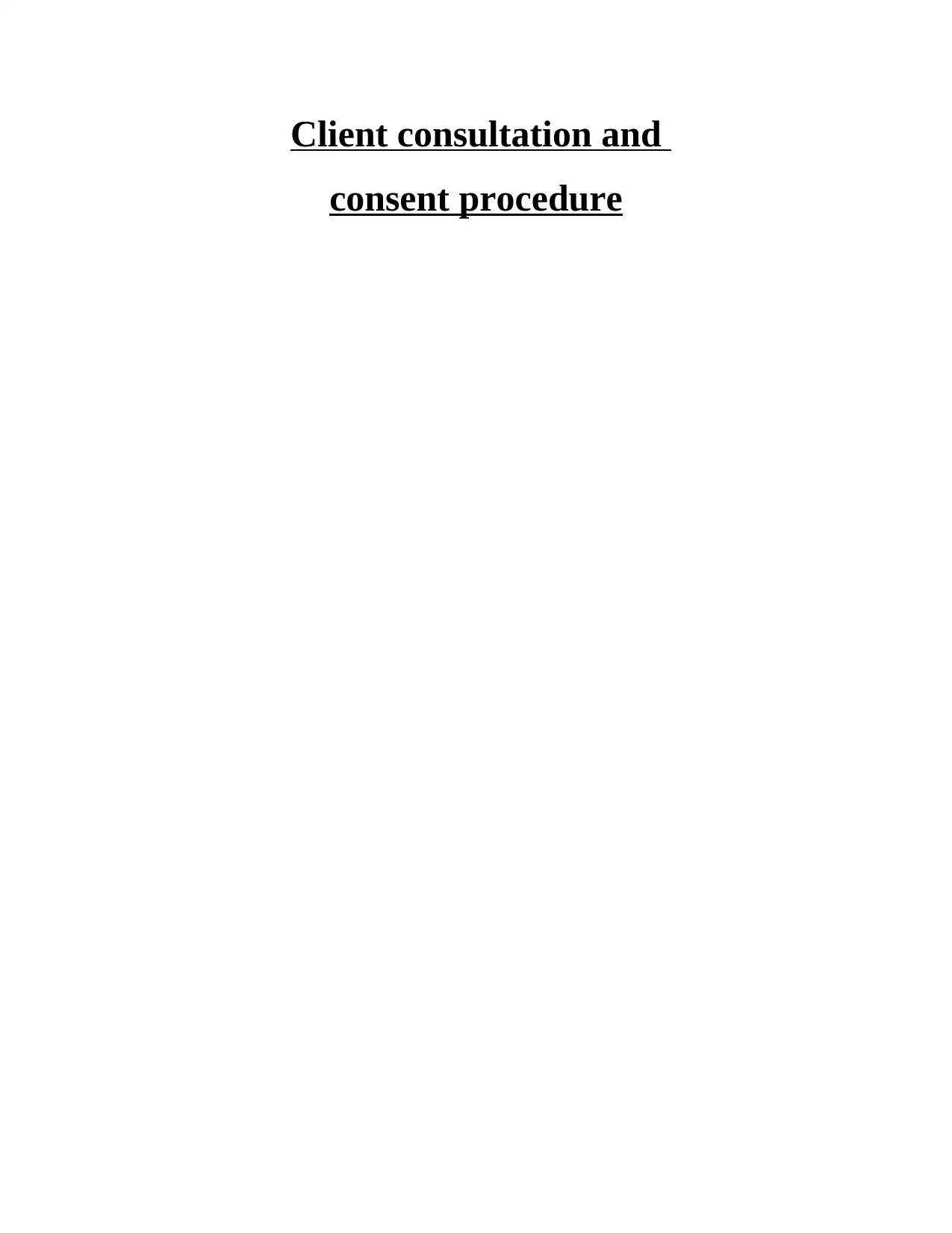
Client consultation and
consent procedure
consent procedure
Paraphrase This Document
Need a fresh take? Get an instant paraphrase of this document with our AI Paraphraser
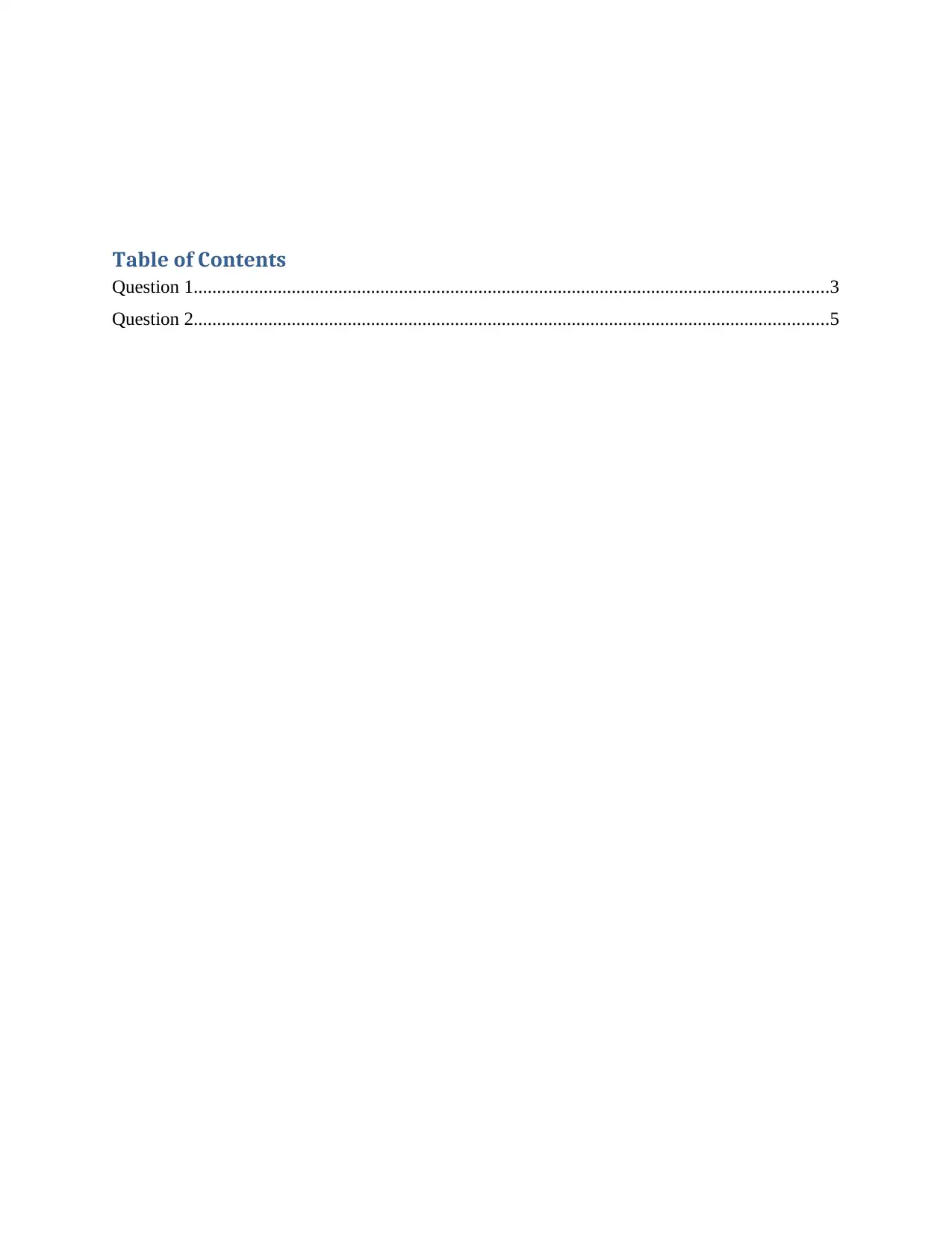
Table of Contents
Question 1........................................................................................................................................3
Question 2........................................................................................................................................5
Question 1........................................................................................................................................3
Question 2........................................................................................................................................5
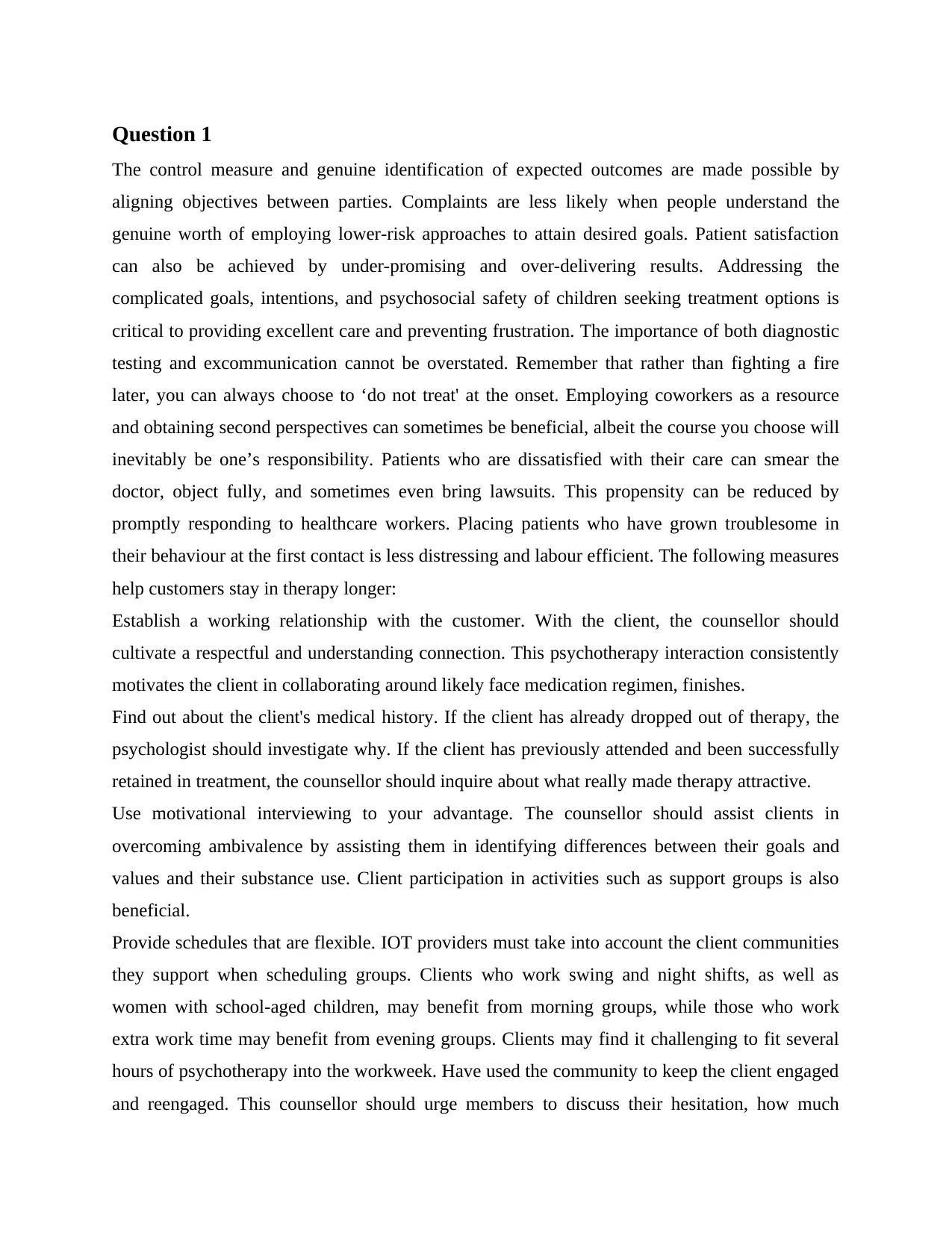
Question 1
The control measure and genuine identification of expected outcomes are made possible by
aligning objectives between parties. Complaints are less likely when people understand the
genuine worth of employing lower-risk approaches to attain desired goals. Patient satisfaction
can also be achieved by under-promising and over-delivering results. Addressing the
complicated goals, intentions, and psychosocial safety of children seeking treatment options is
critical to providing excellent care and preventing frustration. The importance of both diagnostic
testing and excommunication cannot be overstated. Remember that rather than fighting a fire
later, you can always choose to ‘do not treat' at the onset. Employing coworkers as a resource
and obtaining second perspectives can sometimes be beneficial, albeit the course you choose will
inevitably be one’s responsibility. Patients who are dissatisfied with their care can smear the
doctor, object fully, and sometimes even bring lawsuits. This propensity can be reduced by
promptly responding to healthcare workers. Placing patients who have grown troublesome in
their behaviour at the first contact is less distressing and labour efficient. The following measures
help customers stay in therapy longer:
Establish a working relationship with the customer. With the client, the counsellor should
cultivate a respectful and understanding connection. This psychotherapy interaction consistently
motivates the client in collaborating around likely face medication regimen, finishes.
Find out about the client's medical history. If the client has already dropped out of therapy, the
psychologist should investigate why. If the client has previously attended and been successfully
retained in treatment, the counsellor should inquire about what really made therapy attractive.
Use motivational interviewing to your advantage. The counsellor should assist clients in
overcoming ambivalence by assisting them in identifying differences between their goals and
values and their substance use. Client participation in activities such as support groups is also
beneficial.
Provide schedules that are flexible. IOT providers must take into account the client communities
they support when scheduling groups. Clients who work swing and night shifts, as well as
women with school-aged children, may benefit from morning groups, while those who work
extra work time may benefit from evening groups. Clients may find it challenging to fit several
hours of psychotherapy into the workweek. Have used the community to keep the client engaged
and reengaged. This counsellor should urge members to discuss their hesitation, how much
The control measure and genuine identification of expected outcomes are made possible by
aligning objectives between parties. Complaints are less likely when people understand the
genuine worth of employing lower-risk approaches to attain desired goals. Patient satisfaction
can also be achieved by under-promising and over-delivering results. Addressing the
complicated goals, intentions, and psychosocial safety of children seeking treatment options is
critical to providing excellent care and preventing frustration. The importance of both diagnostic
testing and excommunication cannot be overstated. Remember that rather than fighting a fire
later, you can always choose to ‘do not treat' at the onset. Employing coworkers as a resource
and obtaining second perspectives can sometimes be beneficial, albeit the course you choose will
inevitably be one’s responsibility. Patients who are dissatisfied with their care can smear the
doctor, object fully, and sometimes even bring lawsuits. This propensity can be reduced by
promptly responding to healthcare workers. Placing patients who have grown troublesome in
their behaviour at the first contact is less distressing and labour efficient. The following measures
help customers stay in therapy longer:
Establish a working relationship with the customer. With the client, the counsellor should
cultivate a respectful and understanding connection. This psychotherapy interaction consistently
motivates the client in collaborating around likely face medication regimen, finishes.
Find out about the client's medical history. If the client has already dropped out of therapy, the
psychologist should investigate why. If the client has previously attended and been successfully
retained in treatment, the counsellor should inquire about what really made therapy attractive.
Use motivational interviewing to your advantage. The counsellor should assist clients in
overcoming ambivalence by assisting them in identifying differences between their goals and
values and their substance use. Client participation in activities such as support groups is also
beneficial.
Provide schedules that are flexible. IOT providers must take into account the client communities
they support when scheduling groups. Clients who work swing and night shifts, as well as
women with school-aged children, may benefit from morning groups, while those who work
extra work time may benefit from evening groups. Clients may find it challenging to fit several
hours of psychotherapy into the workweek. Have used the community to keep the client engaged
and reengaged. This counsellor should urge members to discuss their hesitation, how much
⊘ This is a preview!⊘
Do you want full access?
Subscribe today to unlock all pages.

Trusted by 1+ million students worldwide
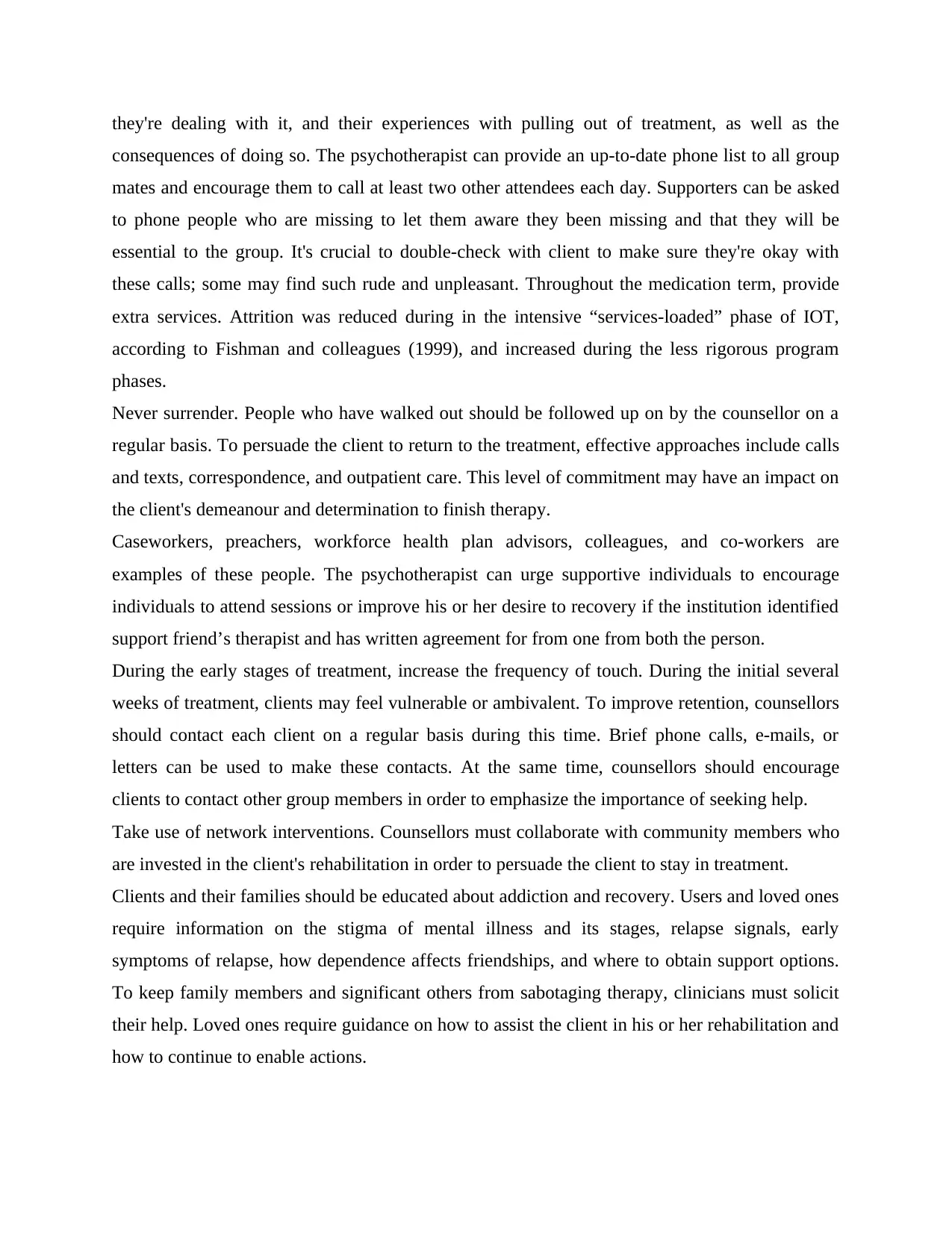
they're dealing with it, and their experiences with pulling out of treatment, as well as the
consequences of doing so. The psychotherapist can provide an up-to-date phone list to all group
mates and encourage them to call at least two other attendees each day. Supporters can be asked
to phone people who are missing to let them aware they been missing and that they will be
essential to the group. It's crucial to double-check with client to make sure they're okay with
these calls; some may find such rude and unpleasant. Throughout the medication term, provide
extra services. Attrition was reduced during in the intensive “services-loaded” phase of IOT,
according to Fishman and colleagues (1999), and increased during the less rigorous program
phases.
Never surrender. People who have walked out should be followed up on by the counsellor on a
regular basis. To persuade the client to return to the treatment, effective approaches include calls
and texts, correspondence, and outpatient care. This level of commitment may have an impact on
the client's demeanour and determination to finish therapy.
Caseworkers, preachers, workforce health plan advisors, colleagues, and co-workers are
examples of these people. The psychotherapist can urge supportive individuals to encourage
individuals to attend sessions or improve his or her desire to recovery if the institution identified
support friend’s therapist and has written agreement for from one from both the person.
During the early stages of treatment, increase the frequency of touch. During the initial several
weeks of treatment, clients may feel vulnerable or ambivalent. To improve retention, counsellors
should contact each client on a regular basis during this time. Brief phone calls, e-mails, or
letters can be used to make these contacts. At the same time, counsellors should encourage
clients to contact other group members in order to emphasize the importance of seeking help.
Take use of network interventions. Counsellors must collaborate with community members who
are invested in the client's rehabilitation in order to persuade the client to stay in treatment.
Clients and their families should be educated about addiction and recovery. Users and loved ones
require information on the stigma of mental illness and its stages, relapse signals, early
symptoms of relapse, how dependence affects friendships, and where to obtain support options.
To keep family members and significant others from sabotaging therapy, clinicians must solicit
their help. Loved ones require guidance on how to assist the client in his or her rehabilitation and
how to continue to enable actions.
consequences of doing so. The psychotherapist can provide an up-to-date phone list to all group
mates and encourage them to call at least two other attendees each day. Supporters can be asked
to phone people who are missing to let them aware they been missing and that they will be
essential to the group. It's crucial to double-check with client to make sure they're okay with
these calls; some may find such rude and unpleasant. Throughout the medication term, provide
extra services. Attrition was reduced during in the intensive “services-loaded” phase of IOT,
according to Fishman and colleagues (1999), and increased during the less rigorous program
phases.
Never surrender. People who have walked out should be followed up on by the counsellor on a
regular basis. To persuade the client to return to the treatment, effective approaches include calls
and texts, correspondence, and outpatient care. This level of commitment may have an impact on
the client's demeanour and determination to finish therapy.
Caseworkers, preachers, workforce health plan advisors, colleagues, and co-workers are
examples of these people. The psychotherapist can urge supportive individuals to encourage
individuals to attend sessions or improve his or her desire to recovery if the institution identified
support friend’s therapist and has written agreement for from one from both the person.
During the early stages of treatment, increase the frequency of touch. During the initial several
weeks of treatment, clients may feel vulnerable or ambivalent. To improve retention, counsellors
should contact each client on a regular basis during this time. Brief phone calls, e-mails, or
letters can be used to make these contacts. At the same time, counsellors should encourage
clients to contact other group members in order to emphasize the importance of seeking help.
Take use of network interventions. Counsellors must collaborate with community members who
are invested in the client's rehabilitation in order to persuade the client to stay in treatment.
Clients and their families should be educated about addiction and recovery. Users and loved ones
require information on the stigma of mental illness and its stages, relapse signals, early
symptoms of relapse, how dependence affects friendships, and where to obtain support options.
To keep family members and significant others from sabotaging therapy, clinicians must solicit
their help. Loved ones require guidance on how to assist the client in his or her rehabilitation and
how to continue to enable actions.
Paraphrase This Document
Need a fresh take? Get an instant paraphrase of this document with our AI Paraphraser
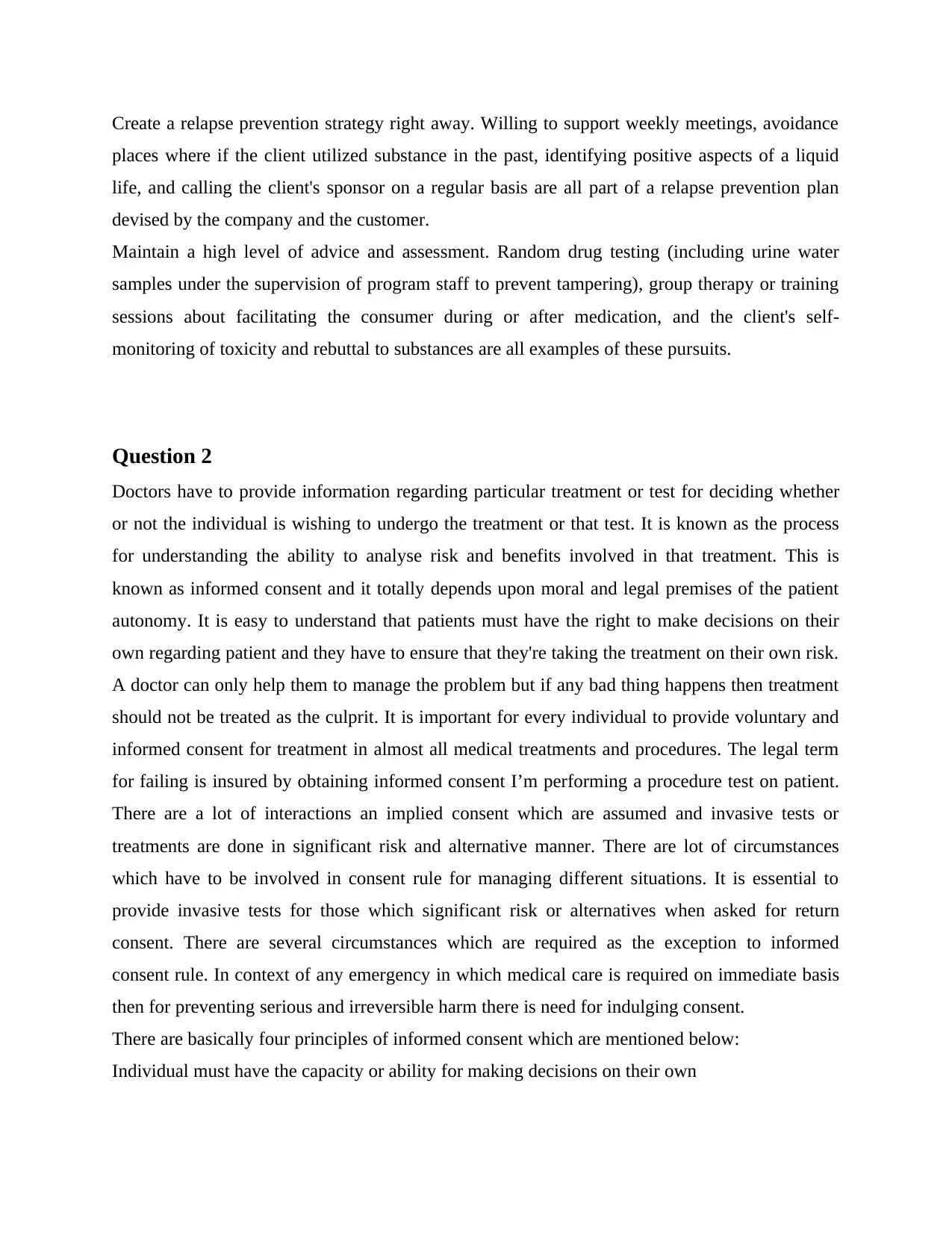
Create a relapse prevention strategy right away. Willing to support weekly meetings, avoidance
places where if the client utilized substance in the past, identifying positive aspects of a liquid
life, and calling the client's sponsor on a regular basis are all part of a relapse prevention plan
devised by the company and the customer.
Maintain a high level of advice and assessment. Random drug testing (including urine water
samples under the supervision of program staff to prevent tampering), group therapy or training
sessions about facilitating the consumer during or after medication, and the client's self-
monitoring of toxicity and rebuttal to substances are all examples of these pursuits.
Question 2
Doctors have to provide information regarding particular treatment or test for deciding whether
or not the individual is wishing to undergo the treatment or that test. It is known as the process
for understanding the ability to analyse risk and benefits involved in that treatment. This is
known as informed consent and it totally depends upon moral and legal premises of the patient
autonomy. It is easy to understand that patients must have the right to make decisions on their
own regarding patient and they have to ensure that they're taking the treatment on their own risk.
A doctor can only help them to manage the problem but if any bad thing happens then treatment
should not be treated as the culprit. It is important for every individual to provide voluntary and
informed consent for treatment in almost all medical treatments and procedures. The legal term
for failing is insured by obtaining informed consent I’m performing a procedure test on patient.
There are a lot of interactions an implied consent which are assumed and invasive tests or
treatments are done in significant risk and alternative manner. There are lot of circumstances
which have to be involved in consent rule for managing different situations. It is essential to
provide invasive tests for those which significant risk or alternatives when asked for return
consent. There are several circumstances which are required as the exception to informed
consent rule. In context of any emergency in which medical care is required on immediate basis
then for preventing serious and irreversible harm there is need for indulging consent.
There are basically four principles of informed consent which are mentioned below:
Individual must have the capacity or ability for making decisions on their own
places where if the client utilized substance in the past, identifying positive aspects of a liquid
life, and calling the client's sponsor on a regular basis are all part of a relapse prevention plan
devised by the company and the customer.
Maintain a high level of advice and assessment. Random drug testing (including urine water
samples under the supervision of program staff to prevent tampering), group therapy or training
sessions about facilitating the consumer during or after medication, and the client's self-
monitoring of toxicity and rebuttal to substances are all examples of these pursuits.
Question 2
Doctors have to provide information regarding particular treatment or test for deciding whether
or not the individual is wishing to undergo the treatment or that test. It is known as the process
for understanding the ability to analyse risk and benefits involved in that treatment. This is
known as informed consent and it totally depends upon moral and legal premises of the patient
autonomy. It is easy to understand that patients must have the right to make decisions on their
own regarding patient and they have to ensure that they're taking the treatment on their own risk.
A doctor can only help them to manage the problem but if any bad thing happens then treatment
should not be treated as the culprit. It is important for every individual to provide voluntary and
informed consent for treatment in almost all medical treatments and procedures. The legal term
for failing is insured by obtaining informed consent I’m performing a procedure test on patient.
There are a lot of interactions an implied consent which are assumed and invasive tests or
treatments are done in significant risk and alternative manner. There are lot of circumstances
which have to be involved in consent rule for managing different situations. It is essential to
provide invasive tests for those which significant risk or alternatives when asked for return
consent. There are several circumstances which are required as the exception to informed
consent rule. In context of any emergency in which medical care is required on immediate basis
then for preventing serious and irreversible harm there is need for indulging consent.
There are basically four principles of informed consent which are mentioned below:
Individual must have the capacity or ability for making decisions on their own
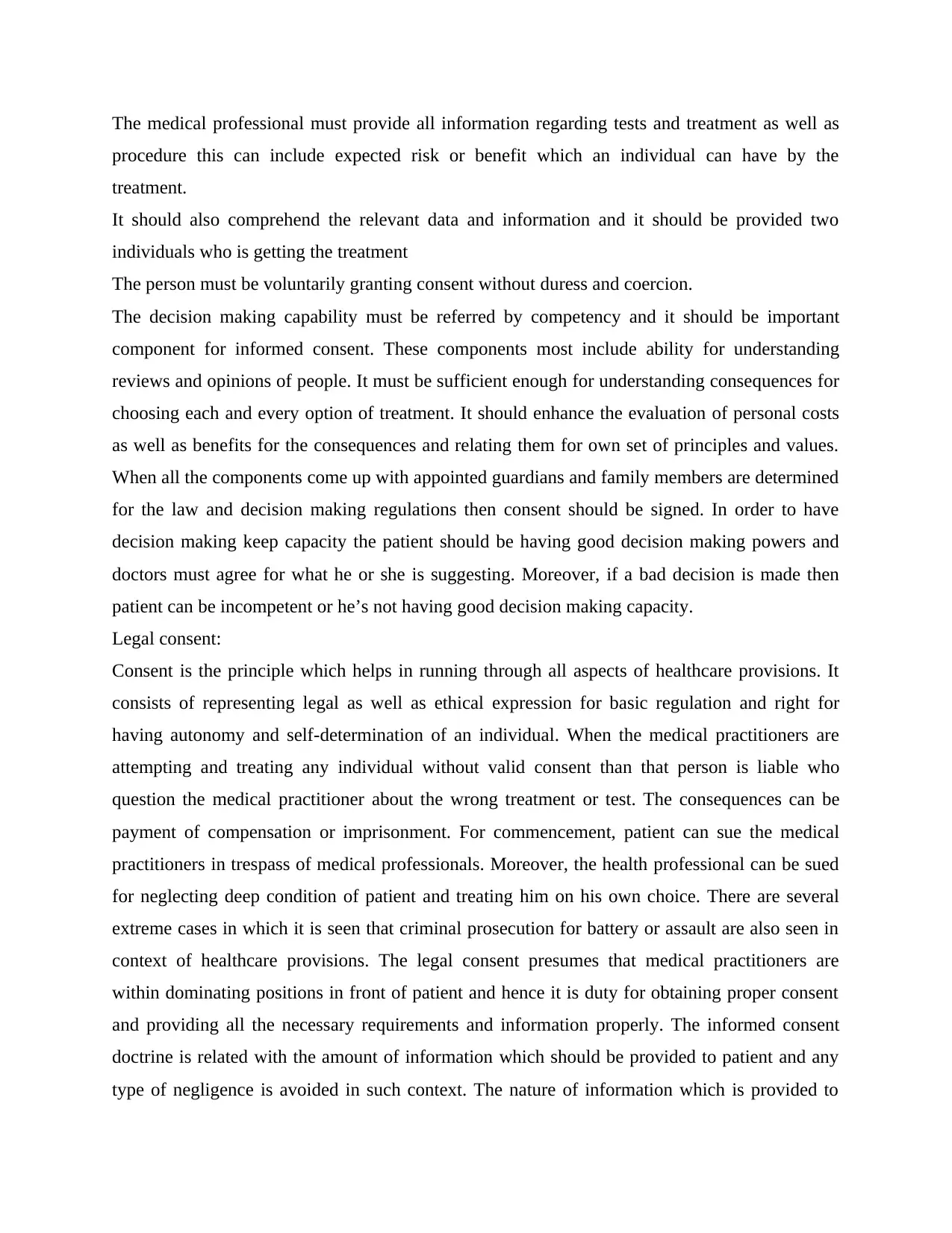
The medical professional must provide all information regarding tests and treatment as well as
procedure this can include expected risk or benefit which an individual can have by the
treatment.
It should also comprehend the relevant data and information and it should be provided two
individuals who is getting the treatment
The person must be voluntarily granting consent without duress and coercion.
The decision making capability must be referred by competency and it should be important
component for informed consent. These components most include ability for understanding
reviews and opinions of people. It must be sufficient enough for understanding consequences for
choosing each and every option of treatment. It should enhance the evaluation of personal costs
as well as benefits for the consequences and relating them for own set of principles and values.
When all the components come up with appointed guardians and family members are determined
for the law and decision making regulations then consent should be signed. In order to have
decision making keep capacity the patient should be having good decision making powers and
doctors must agree for what he or she is suggesting. Moreover, if a bad decision is made then
patient can be incompetent or he’s not having good decision making capacity.
Legal consent:
Consent is the principle which helps in running through all aspects of healthcare provisions. It
consists of representing legal as well as ethical expression for basic regulation and right for
having autonomy and self-determination of an individual. When the medical practitioners are
attempting and treating any individual without valid consent than that person is liable who
question the medical practitioner about the wrong treatment or test. The consequences can be
payment of compensation or imprisonment. For commencement, patient can sue the medical
practitioners in trespass of medical professionals. Moreover, the health professional can be sued
for neglecting deep condition of patient and treating him on his own choice. There are several
extreme cases in which it is seen that criminal prosecution for battery or assault are also seen in
context of healthcare provisions. The legal consent presumes that medical practitioners are
within dominating positions in front of patient and hence it is duty for obtaining proper consent
and providing all the necessary requirements and information properly. The informed consent
doctrine is related with the amount of information which should be provided to patient and any
type of negligence is avoided in such context. The nature of information which is provided to
procedure this can include expected risk or benefit which an individual can have by the
treatment.
It should also comprehend the relevant data and information and it should be provided two
individuals who is getting the treatment
The person must be voluntarily granting consent without duress and coercion.
The decision making capability must be referred by competency and it should be important
component for informed consent. These components most include ability for understanding
reviews and opinions of people. It must be sufficient enough for understanding consequences for
choosing each and every option of treatment. It should enhance the evaluation of personal costs
as well as benefits for the consequences and relating them for own set of principles and values.
When all the components come up with appointed guardians and family members are determined
for the law and decision making regulations then consent should be signed. In order to have
decision making keep capacity the patient should be having good decision making powers and
doctors must agree for what he or she is suggesting. Moreover, if a bad decision is made then
patient can be incompetent or he’s not having good decision making capacity.
Legal consent:
Consent is the principle which helps in running through all aspects of healthcare provisions. It
consists of representing legal as well as ethical expression for basic regulation and right for
having autonomy and self-determination of an individual. When the medical practitioners are
attempting and treating any individual without valid consent than that person is liable who
question the medical practitioner about the wrong treatment or test. The consequences can be
payment of compensation or imprisonment. For commencement, patient can sue the medical
practitioners in trespass of medical professionals. Moreover, the health professional can be sued
for neglecting deep condition of patient and treating him on his own choice. There are several
extreme cases in which it is seen that criminal prosecution for battery or assault are also seen in
context of healthcare provisions. The legal consent presumes that medical practitioners are
within dominating positions in front of patient and hence it is duty for obtaining proper consent
and providing all the necessary requirements and information properly. The informed consent
doctrine is related with the amount of information which should be provided to patient and any
type of negligence is avoided in such context. The nature of information which is provided to
⊘ This is a preview!⊘
Do you want full access?
Subscribe today to unlock all pages.

Trusted by 1+ million students worldwide
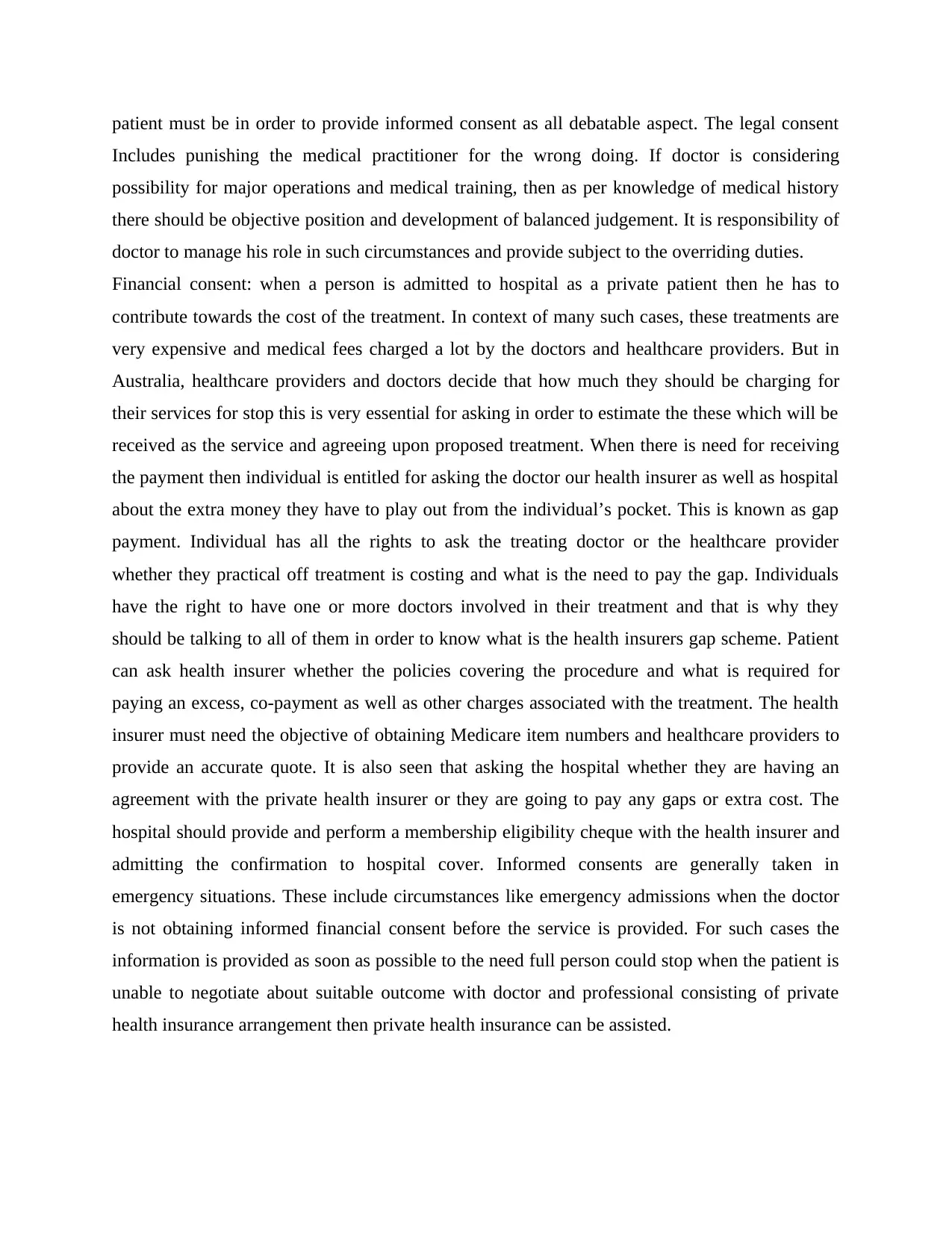
patient must be in order to provide informed consent as all debatable aspect. The legal consent
Includes punishing the medical practitioner for the wrong doing. If doctor is considering
possibility for major operations and medical training, then as per knowledge of medical history
there should be objective position and development of balanced judgement. It is responsibility of
doctor to manage his role in such circumstances and provide subject to the overriding duties.
Financial consent: when a person is admitted to hospital as a private patient then he has to
contribute towards the cost of the treatment. In context of many such cases, these treatments are
very expensive and medical fees charged a lot by the doctors and healthcare providers. But in
Australia, healthcare providers and doctors decide that how much they should be charging for
their services for stop this is very essential for asking in order to estimate the these which will be
received as the service and agreeing upon proposed treatment. When there is need for receiving
the payment then individual is entitled for asking the doctor our health insurer as well as hospital
about the extra money they have to play out from the individual’s pocket. This is known as gap
payment. Individual has all the rights to ask the treating doctor or the healthcare provider
whether they practical off treatment is costing and what is the need to pay the gap. Individuals
have the right to have one or more doctors involved in their treatment and that is why they
should be talking to all of them in order to know what is the health insurers gap scheme. Patient
can ask health insurer whether the policies covering the procedure and what is required for
paying an excess, co-payment as well as other charges associated with the treatment. The health
insurer must need the objective of obtaining Medicare item numbers and healthcare providers to
provide an accurate quote. It is also seen that asking the hospital whether they are having an
agreement with the private health insurer or they are going to pay any gaps or extra cost. The
hospital should provide and perform a membership eligibility cheque with the health insurer and
admitting the confirmation to hospital cover. Informed consents are generally taken in
emergency situations. These include circumstances like emergency admissions when the doctor
is not obtaining informed financial consent before the service is provided. For such cases the
information is provided as soon as possible to the need full person could stop when the patient is
unable to negotiate about suitable outcome with doctor and professional consisting of private
health insurance arrangement then private health insurance can be assisted.
Includes punishing the medical practitioner for the wrong doing. If doctor is considering
possibility for major operations and medical training, then as per knowledge of medical history
there should be objective position and development of balanced judgement. It is responsibility of
doctor to manage his role in such circumstances and provide subject to the overriding duties.
Financial consent: when a person is admitted to hospital as a private patient then he has to
contribute towards the cost of the treatment. In context of many such cases, these treatments are
very expensive and medical fees charged a lot by the doctors and healthcare providers. But in
Australia, healthcare providers and doctors decide that how much they should be charging for
their services for stop this is very essential for asking in order to estimate the these which will be
received as the service and agreeing upon proposed treatment. When there is need for receiving
the payment then individual is entitled for asking the doctor our health insurer as well as hospital
about the extra money they have to play out from the individual’s pocket. This is known as gap
payment. Individual has all the rights to ask the treating doctor or the healthcare provider
whether they practical off treatment is costing and what is the need to pay the gap. Individuals
have the right to have one or more doctors involved in their treatment and that is why they
should be talking to all of them in order to know what is the health insurers gap scheme. Patient
can ask health insurer whether the policies covering the procedure and what is required for
paying an excess, co-payment as well as other charges associated with the treatment. The health
insurer must need the objective of obtaining Medicare item numbers and healthcare providers to
provide an accurate quote. It is also seen that asking the hospital whether they are having an
agreement with the private health insurer or they are going to pay any gaps or extra cost. The
hospital should provide and perform a membership eligibility cheque with the health insurer and
admitting the confirmation to hospital cover. Informed consents are generally taken in
emergency situations. These include circumstances like emergency admissions when the doctor
is not obtaining informed financial consent before the service is provided. For such cases the
information is provided as soon as possible to the need full person could stop when the patient is
unable to negotiate about suitable outcome with doctor and professional consisting of private
health insurance arrangement then private health insurance can be assisted.
Paraphrase This Document
Need a fresh take? Get an instant paraphrase of this document with our AI Paraphraser
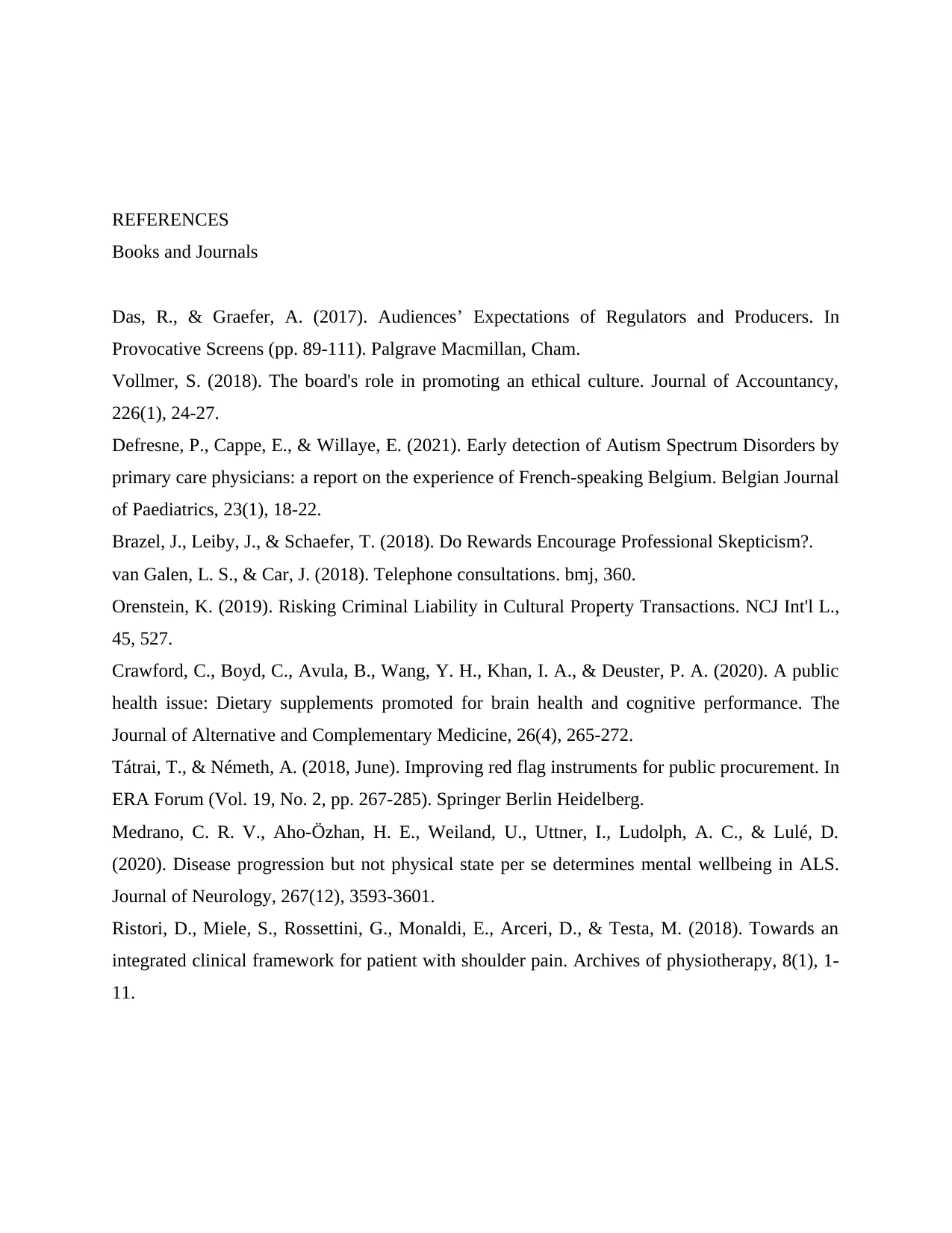
REFERENCES
Books and Journals
Das, R., & Graefer, A. (2017). Audiences’ Expectations of Regulators and Producers. In
Provocative Screens (pp. 89-111). Palgrave Macmillan, Cham.
Vollmer, S. (2018). The board's role in promoting an ethical culture. Journal of Accountancy,
226(1), 24-27.
Defresne, P., Cappe, E., & Willaye, E. (2021). Early detection of Autism Spectrum Disorders by
primary care physicians: a report on the experience of French-speaking Belgium. Belgian Journal
of Paediatrics, 23(1), 18-22.
Brazel, J., Leiby, J., & Schaefer, T. (2018). Do Rewards Encourage Professional Skepticism?.
van Galen, L. S., & Car, J. (2018). Telephone consultations. bmj, 360.
Orenstein, K. (2019). Risking Criminal Liability in Cultural Property Transactions. NCJ Int'l L.,
45, 527.
Crawford, C., Boyd, C., Avula, B., Wang, Y. H., Khan, I. A., & Deuster, P. A. (2020). A public
health issue: Dietary supplements promoted for brain health and cognitive performance. The
Journal of Alternative and Complementary Medicine, 26(4), 265-272.
Tátrai, T., & Németh, A. (2018, June). Improving red flag instruments for public procurement. In
ERA Forum (Vol. 19, No. 2, pp. 267-285). Springer Berlin Heidelberg.
Medrano, C. R. V., Aho-Özhan, H. E., Weiland, U., Uttner, I., Ludolph, A. C., & Lulé, D.
(2020). Disease progression but not physical state per se determines mental wellbeing in ALS.
Journal of Neurology, 267(12), 3593-3601.
Ristori, D., Miele, S., Rossettini, G., Monaldi, E., Arceri, D., & Testa, M. (2018). Towards an
integrated clinical framework for patient with shoulder pain. Archives of physiotherapy, 8(1), 1-
11.
Books and Journals
Das, R., & Graefer, A. (2017). Audiences’ Expectations of Regulators and Producers. In
Provocative Screens (pp. 89-111). Palgrave Macmillan, Cham.
Vollmer, S. (2018). The board's role in promoting an ethical culture. Journal of Accountancy,
226(1), 24-27.
Defresne, P., Cappe, E., & Willaye, E. (2021). Early detection of Autism Spectrum Disorders by
primary care physicians: a report on the experience of French-speaking Belgium. Belgian Journal
of Paediatrics, 23(1), 18-22.
Brazel, J., Leiby, J., & Schaefer, T. (2018). Do Rewards Encourage Professional Skepticism?.
van Galen, L. S., & Car, J. (2018). Telephone consultations. bmj, 360.
Orenstein, K. (2019). Risking Criminal Liability in Cultural Property Transactions. NCJ Int'l L.,
45, 527.
Crawford, C., Boyd, C., Avula, B., Wang, Y. H., Khan, I. A., & Deuster, P. A. (2020). A public
health issue: Dietary supplements promoted for brain health and cognitive performance. The
Journal of Alternative and Complementary Medicine, 26(4), 265-272.
Tátrai, T., & Németh, A. (2018, June). Improving red flag instruments for public procurement. In
ERA Forum (Vol. 19, No. 2, pp. 267-285). Springer Berlin Heidelberg.
Medrano, C. R. V., Aho-Özhan, H. E., Weiland, U., Uttner, I., Ludolph, A. C., & Lulé, D.
(2020). Disease progression but not physical state per se determines mental wellbeing in ALS.
Journal of Neurology, 267(12), 3593-3601.
Ristori, D., Miele, S., Rossettini, G., Monaldi, E., Arceri, D., & Testa, M. (2018). Towards an
integrated clinical framework for patient with shoulder pain. Archives of physiotherapy, 8(1), 1-
11.
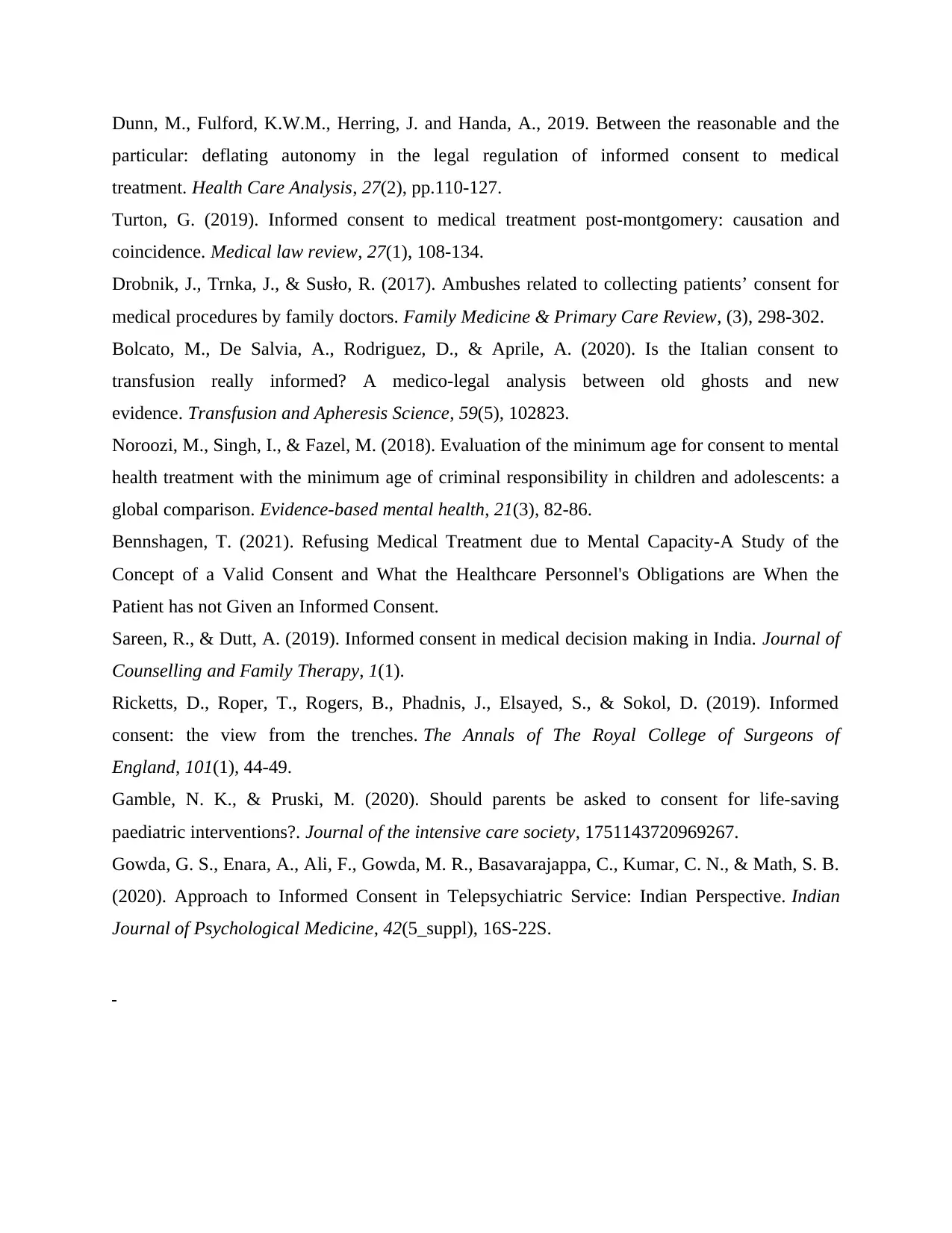
Dunn, M., Fulford, K.W.M., Herring, J. and Handa, A., 2019. Between the reasonable and the
particular: deflating autonomy in the legal regulation of informed consent to medical
treatment. Health Care Analysis, 27(2), pp.110-127.
Turton, G. (2019). Informed consent to medical treatment post-montgomery: causation and
coincidence. Medical law review, 27(1), 108-134.
Drobnik, J., Trnka, J., & Susło, R. (2017). Ambushes related to collecting patients’ consent for
medical procedures by family doctors. Family Medicine & Primary Care Review, (3), 298-302.
Bolcato, M., De Salvia, A., Rodriguez, D., & Aprile, A. (2020). Is the Italian consent to
transfusion really informed? A medico-legal analysis between old ghosts and new
evidence. Transfusion and Apheresis Science, 59(5), 102823.
Noroozi, M., Singh, I., & Fazel, M. (2018). Evaluation of the minimum age for consent to mental
health treatment with the minimum age of criminal responsibility in children and adolescents: a
global comparison. Evidence-based mental health, 21(3), 82-86.
Bennshagen, T. (2021). Refusing Medical Treatment due to Mental Capacity-A Study of the
Concept of a Valid Consent and What the Healthcare Personnel's Obligations are When the
Patient has not Given an Informed Consent.
Sareen, R., & Dutt, A. (2019). Informed consent in medical decision making in India. Journal of
Counselling and Family Therapy, 1(1).
Ricketts, D., Roper, T., Rogers, B., Phadnis, J., Elsayed, S., & Sokol, D. (2019). Informed
consent: the view from the trenches. The Annals of The Royal College of Surgeons of
England, 101(1), 44-49.
Gamble, N. K., & Pruski, M. (2020). Should parents be asked to consent for life-saving
paediatric interventions?. Journal of the intensive care society, 1751143720969267.
Gowda, G. S., Enara, A., Ali, F., Gowda, M. R., Basavarajappa, C., Kumar, C. N., & Math, S. B.
(2020). Approach to Informed Consent in Telepsychiatric Service: Indian Perspective. Indian
Journal of Psychological Medicine, 42(5_suppl), 16S-22S.
particular: deflating autonomy in the legal regulation of informed consent to medical
treatment. Health Care Analysis, 27(2), pp.110-127.
Turton, G. (2019). Informed consent to medical treatment post-montgomery: causation and
coincidence. Medical law review, 27(1), 108-134.
Drobnik, J., Trnka, J., & Susło, R. (2017). Ambushes related to collecting patients’ consent for
medical procedures by family doctors. Family Medicine & Primary Care Review, (3), 298-302.
Bolcato, M., De Salvia, A., Rodriguez, D., & Aprile, A. (2020). Is the Italian consent to
transfusion really informed? A medico-legal analysis between old ghosts and new
evidence. Transfusion and Apheresis Science, 59(5), 102823.
Noroozi, M., Singh, I., & Fazel, M. (2018). Evaluation of the minimum age for consent to mental
health treatment with the minimum age of criminal responsibility in children and adolescents: a
global comparison. Evidence-based mental health, 21(3), 82-86.
Bennshagen, T. (2021). Refusing Medical Treatment due to Mental Capacity-A Study of the
Concept of a Valid Consent and What the Healthcare Personnel's Obligations are When the
Patient has not Given an Informed Consent.
Sareen, R., & Dutt, A. (2019). Informed consent in medical decision making in India. Journal of
Counselling and Family Therapy, 1(1).
Ricketts, D., Roper, T., Rogers, B., Phadnis, J., Elsayed, S., & Sokol, D. (2019). Informed
consent: the view from the trenches. The Annals of The Royal College of Surgeons of
England, 101(1), 44-49.
Gamble, N. K., & Pruski, M. (2020). Should parents be asked to consent for life-saving
paediatric interventions?. Journal of the intensive care society, 1751143720969267.
Gowda, G. S., Enara, A., Ali, F., Gowda, M. R., Basavarajappa, C., Kumar, C. N., & Math, S. B.
(2020). Approach to Informed Consent in Telepsychiatric Service: Indian Perspective. Indian
Journal of Psychological Medicine, 42(5_suppl), 16S-22S.
⊘ This is a preview!⊘
Do you want full access?
Subscribe today to unlock all pages.

Trusted by 1+ million students worldwide
1 out of 9
Related Documents
Your All-in-One AI-Powered Toolkit for Academic Success.
+13062052269
info@desklib.com
Available 24*7 on WhatsApp / Email
![[object Object]](/_next/static/media/star-bottom.7253800d.svg)
Unlock your academic potential
Copyright © 2020–2025 A2Z Services. All Rights Reserved. Developed and managed by ZUCOL.




